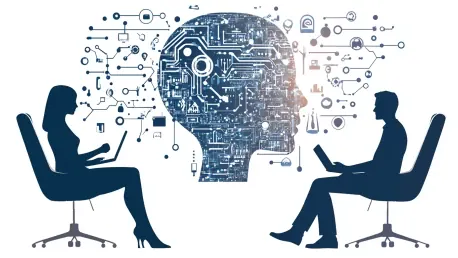The rapid evolution of technology is reshaping enterprise systems, with a potential shift from Software as a Service (SaaS) to autonomous AI agents and even further to Autonomous Service Ecosystems (ASEs). As AI agents continue to advance in their capabilities, they promise to not only enhance existing software solutions but also fundamentally transform how businesses operate, paving the way for a future where autonomous systems drive decision-making and execution.
The Evolution: From SaaS to AI Agents
Over the past two decades, SaaS has become a cornerstone of enterprise technology, known for its scalability, flexibility, and cost-efficiency. SaaS applications, such as CRM systems and collaborative tools, have become essential across organizations of various sizes. The transformative impact of SaaS on business operations has been unequivocal. However, with the rapid development of AI technology, particularly in the form of AI agents, the landscape of enterprise software is poised for a significant transformation.
The Rise of AI Agents
Initially perceived as an implausible idea, the replacement of SaaS by AI agents gains traction as these agents transcend their role as narrowly focused tools to become autonomous decision-making systems. Early conversational chatbots like Siri and Alexa have significantly advanced, now powered by large language models (LLMs), multimodal AI, and reinforcement learning principles. These advancements enable AI agents to perform complex tasks, exhibit contextual awareness, and interact seamlessly with both humans and machines without traditional user interfaces.
The progression from basic chatbots to sophisticated AI agents underscores a pivotal shift in enterprise technology. Modern AI agents are no longer confined to simple query responses; they are equipped to understand and interpret nuanced language, recognize patterns, and make informed decisions based on real-time data. Such capabilities position AI agents as formidable contenders to SaaS, as they offer a level of automation and intelligence that traditional software solutions cannot match. As these AI agents become more prevalent, businesses may find themselves relying less on conventional software and more on intelligent systems that can autonomously drive processes and outcomes.
Capabilities of Modern AI Agents
Modern AI agents possess several transformative capabilities that distinguish them from traditional SaaS applications. One of the most notable is the automation of workflows. AI agents can autonomously handle processes across various systems, reducing the need for human intervention and streamlining operations. This level of automation extends beyond simple task execution to include dynamic learning and adaptation. These agents continuously learn from new data and user interactions, enabling them to adapt to changing environments and evolving business needs in real-time.
Another significant advantage of AI agents is their seamless human-machine interface. Unlike traditional software that relies on dashboards and user interfaces for interaction, AI agents can directly communicate with users and other machines, making the entire process more efficient and user-friendly. This eliminates the need for complex interfaces and allows for more intuitive and natural interactions. Additionally, AI agents excel in contextual decision-making. They can integrate data from multiple sources, understand the context of various scenarios, and make decisions aligned with predefined business goals. This capacity for contextual awareness and decision-making empowers AI agents to undertake multifaceted roles within organizations, from managing HR functions and financial operations to optimizing marketing campaigns and supply chain logistics.
Transitional Phase: From SaaS to AI-as-a-Service (AIaaS)
The transition from SaaS to an AI-dominated future will likely be incremental, involving an intermediate stage where SaaS companies increasingly incorporate AI features. Companies like OpenAI, Anthropic, and Google are spearheading the development of AI-as-a-Service (AIaaS) platforms. These platforms offer businesses the ability to deploy intelligent agents for specialized tasks, facilitating the gradual shift from traditional SaaS to more autonomous systems.
Enhancing User Experience with AI
While AI features in SaaS applications currently enhance user experience, AI agents represent a fundamental departure by eliminating the need for user interaction with the software altogether. For example, marketing teams could rely on AI agents to autonomously craft, execute, and optimize campaigns, receiving reports only on critical outcomes. This shift not only reduces the workload on human employees but also ensures that tasks are performed with a high degree of precision and efficiency.
The integration of AI features into SaaS applications marks the beginning of a transformative journey towards full autonomy. As AI capabilities become more advanced, businesses will increasingly depend on AI agents to handle complex processes, from data analysis and predictive modeling to strategic planning and decision-making. This transition will be characterized by a seamless blend of human expertise and machine intelligence, ultimately leading to a workplace where humans focus on high-level goals and creative problem-solving while AI agents manage routine and data-driven tasks.
Advantages of AI Agents Over SaaS
AI agents have the potential to replace SaaS due to several key advantages. One of the most compelling is their ability to provide end-to-end autonomy. Unlike SaaS tools that require human operation, AI agents promise complete autonomy, delivering outcomes directly and eliminating the need for user interfaces. This level of autonomy translates to significant time and cost savings for businesses, as there is less reliance on manual intervention and more emphasis on achieving desired results through intelligent automation.
Another crucial advantage is contextual awareness. AI agents integrate data from multiple systems and make context-aware decisions in real-time, reducing reliance on siloed SaaS applications. This ability to understand and respond to complex scenarios ensures that AI agents can provide more accurate and relevant solutions, enhancing overall business performance. Additionally, AI agents often operate on task-based or usage-based pricing models, offering a scalable alternative that does not depend on user headcounts or manual interaction. This cost efficiency makes AI agents an attractive option for businesses looking to optimize their operations while managing expenses effectively.
Furthermore, AI agents bring hyper-personalization and adaptability to the table. These agents continuously learn and adapt without the need for manual updates, ensuring they remain responsive to changing business requirements. This continuous evolution enables AI agents to provide tailored solutions that meet the specific needs of each organization, fostering a more efficient and effective workflow. As AI agents continue to evolve and improve, their potential to replace traditional SaaS applications becomes increasingly apparent, promising a future where intelligent systems drive business operations with greater precision and insight.
The Prospective Shift: Beyond SaaS and AI Agents
Looking beyond the potential replacement of SaaS by AI agents, the concept of Autonomous Service Ecosystems (ASEs) emerges as the next frontier in enterprise technology. ASEs represent a paradigm where technology evolves from discrete tools or agents to self-organizing, decentralized networks of autonomous systems. This shift underscores a transformative vision of the future, where businesses harness the power of interconnected intelligent systems to drive innovation and efficiency.
Autonomous Service Ecosystems (ASEs)
ASEs are conceived as decentralized networks where technology no longer functions as individual tools but as networks of micro-agents. These micro-agents operate independently, each specializing in distinct tasks and collaborating seamlessly, akin to neural networks in the human brain. This distributed intelligence model enables businesses to leverage multiple autonomous systems that work in concert to achieve complex objectives efficiently.
The implementation of ASEs relies heavily on advanced technologies such as blockchain and smart contracts. By leveraging blockchain, ASEs facilitate tokenized interactions and autonomous negotiations between micro-agents. Smart contracts enable these interactions to be executed seamlessly and transparently, ensuring that all transactions are secure and verifiable. Additionally, ASEs are designed to be self-optimizing networks. Through collaborative learning techniques like federated learning, these ecosystems continuously enhance their operations while maintaining data privacy and security. This collaborative learning approach allows ASEs to adapt and improve organically, driven by the collective intelligence of interconnected micro-agents.
Human-Tech Symbiosis Within ASEs
In the context of ASEs, a symbiotic relationship between humans and technology is envisioned. Humans define high-level goals and strategies, while the ASE dynamically adjusts functions to meet these objectives. This human-tech symbiosis ensures that decision-making processes are still guided by human insight and creativity, but are executed with the precision and efficiency of autonomous systems. The dynamic adjustment capabilities of ASEs also mean that they can respond swiftly to changing business environments, ensuring that organizations remain agile and competitive.
The potential of ASEs extends to delivering unprecedented efficiency gains by automating not just tasks but also the decision-making processes surrounding them. Small businesses could access enterprise-grade capabilities, democratizing technology adoption, and leveling the competitive playing field. However, integrating ASEs presents several challenges, including ensuring interoperability among various micro-agents and establishing robust governance structures to address ethical concerns and accountability. Additionally, fostering trust in decentralized systems is crucial for widespread adoption, requiring businesses to overcome technological inertia and demonstrate the reliability and security of ASEs.
Impact and Challenges for Businesses
The potential of ASEs extends to delivering unprecedented efficiency gains by automating not just tasks but also the decision-making processes surrounding them. This level of automation promises significant benefits for businesses, from reducing operational costs to enhancing productivity and innovation. By leveraging ASEs, companies can streamline their processes, allowing employees to focus on more strategic and creative endeavors, ultimately driving growth and competitiveness.
However, the integration of ASEs would present several challenges. One of the primary challenges is interoperability. Ensuring seamless communication and collaboration between numerous micro-agents necessitates standardized protocols and robust technical frameworks. Developing and implementing these standards will be crucial for the successful deployment and operation of ASEs. Additionally, as autonomous systems increasingly take over decision-making, ethical concerns and accountability for errors or unintended consequences must be addressed through robust governance structures. Establishing clear guidelines and accountability measures will be essential in maintaining trust and ensuring that these systems operate ethically and responsibly.
Another significant challenge is building trust and fostering adoption. Convincing businesses to transition to decentralized systems requires overcoming technological inertia and demonstrating the reliability and security of ASEs. This process involves educating stakeholders about the benefits of ASEs, showcasing successful implementations, and providing comprehensive support during the transition period. By addressing these challenges, businesses can pave the way for a future where ASEs drive innovation and efficiency, creating a more dynamic and competitive business landscape.
Conclusion: From SaaS to a World Without Traditional Software
The swift development of technology is revolutionizing enterprise systems, indicating a potential progression from Software as a Service (SaaS) to sophisticated autonomous AI agents. These AI agents are becoming increasingly advanced, offering capabilities that promise not only to enhance existing software solutions but also to fundamentally change business operations. The move toward autonomous AI agents is setting the stage for an even more profound transformation, where Autonomous Service Ecosystems (ASEs) could take the reins of decision-making and execution processes.
In the near future, businesses may rely heavily on these ASEs to streamline functions, optimize resources, and make real-time decisions without human intervention. This shift could lead to a new era of efficiency and innovation, as autonomous systems handle tasks that currently require extensive human effort and oversight. From customer service to supply chain management, every facet of enterprise operations stands to benefit from the integration of these advanced AI technologies.
As industries brace for this transition, the potential for AI-driven solutions to not only execute tasks but also to learn and adapt from vast amounts of data could redefine competitive dynamics and operational standards. The rise of ASEs signifies not just an incremental improvement, but a fundamental overhaul in how businesses will function, emphasizing speed, accuracy, and adaptability in the relentless pursuit of excellence. With AI at the helm, businesses can expect a future where efficiency is maximized and innovation is unbounded.









